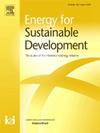Dual-power generation by the solar cell and the Seebeck-effect-based thermoelectric setup
IF 4.9
2区 工程技术
Q2 ENERGY & FUELS
引用次数: 0
Abstract
This study proposes a design to improve solar power conversion efficiency. Not only is the Seebeck effect utilized to generate electrical power using temperature differences, but it can also simultaneously increase the photovoltaic conversion efficiency of solar cells. We used an infrared filter, thermoelectric cooler module, Fresnel lens, parabolic concentrator, and copper heat pipe heatsink to form a temperature-difference electrical power generation architecture. We conducted experiments both indoors and outdoors. Through eight sets of indoor experiments, we found the best design in focusing. The deep parabolic concentrator has a better focusing effect than the shallow parabolic concentrator. In the outdoor experiment, the thermoelectric power generation device equipped with an infrared filter was placed diagonally in front of a fixed solar cell. In the morning, it received the reflected sunlight from the solar cell and focused the infrared light with a wavelength longer than 700 nm onto the thermoelectric cooler module to generate electric power. In the afternoon, sunlight shines directly on the infrared filter and reflects light with a wavelength shorter than 700nm to the solar cells to generate electrical power. By utilizing the Seebeck effect, we can obtain an additional 5.2% of the electrical power output and an additional 50% power output of the solar cell at 2:00PM, achieving a design that improves the efficiency of solar energy conversion. In addition, the IR filter helps to realize the dual functions of power generation and temperature control.
太阳能电池和基于塞贝克效应的热电装置的双重发电
本研究提出一种提高太阳能转换效率的设计方案。塞贝克效应不仅可以利用温差发电,还可以同时提高太阳能电池的光伏转换效率。我们使用红外滤光片、热电冷却器模块、菲涅耳透镜、抛物面聚光器和铜热管散热器组成温差发电架构。我们在室内和室外都进行了实验。通过八组室内实验,我们找到了最佳的聚焦设计。深抛物面聚光器比浅抛物面聚光器具有更好的聚焦效果。在室外实验中,将装有红外滤光片的热电发电装置斜置在固定太阳能电池前。早晨接收太阳能电池反射的太阳光,将波长大于700nm的红外光聚焦到热电冷却器模块上发电。下午,阳光直接照射到红外滤光片上,将波长短于700nm的光反射到太阳能电池上,产生电能。利用塞贝克效应,我们可以在下午2点获得太阳能电池额外的5.2%的电力输出和额外的50%的电力输出,从而实现提高太阳能转换效率的设计。此外,红外滤波器有助于实现发电和温度控制的双重功能。
本文章由计算机程序翻译,如有差异,请以英文原文为准。
求助全文
约1分钟内获得全文
求助全文
来源期刊

Energy for Sustainable Development
ENERGY & FUELS-ENERGY & FUELS
CiteScore
8.10
自引率
9.10%
发文量
187
审稿时长
6-12 weeks
期刊介绍:
Published on behalf of the International Energy Initiative, Energy for Sustainable Development is the journal for decision makers, managers, consultants, policy makers, planners and researchers in both government and non-government organizations. It publishes original research and reviews about energy in developing countries, sustainable development, energy resources, technologies, policies and interactions.
 求助内容:
求助内容: 应助结果提醒方式:
应助结果提醒方式:


